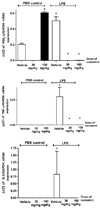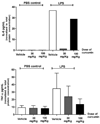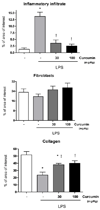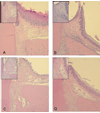Curcumin modulates the immune response associated with LPS-induced periodontal disease in rats
- PMID: 21242275
- PMCID: PMC3132291
- DOI: 10.1177/1753425910392935
Curcumin modulates the immune response associated with LPS-induced periodontal disease in rats
Abstract
Curcumin is a plant-derived dietary spice ascribed various biological activities. Curcumin therapeutic applications have been studied in a variety of conditions, but not on periodontal disease. Periodontal disease is a chronic inflammatory condition initiated by an immune response to micro-organisms of the dental biofilm. Experimental periodontal disease was induced in rats by injecting LPS in the gingival tissues on the palatal aspect of upper first molars (30 µg LPS, 3 times/week for 2 weeks). Curcumin was administered to rats daily via oral gavage at 30 and 100 mg/kg body weight. Reverse transcriptase-qPCR and ELISA were used to determine the expression of IL-6, TNF-α and prostaglandin E(2) synthase on the gingival tissues. The inflammatory status was evaluated by stereometric and descriptive analysis on hematoxylin/eosin-stained sections, whereas modulation of p38 MAPK and NK-κB signaling was assessed by Western blot. Curcumin effectively inhibited cytokine gene expression at mRNA and protein levels, but NF-κB was inhibited only with the lower dose of curcumin, whereas p38 MAPK activation was not affected. Curcumin produced a significant reduction on the inflammatory infiltrate and increased collagen content and fibroblastic cell numbers. Curcumin potently inhibits innate immune responses associated with periodontal disease, suggesting a therapeutic potential in this chronic inflammatory condition.
Figures





Similar articles
-
Potent anti-inflammatory effects of systemically administered curcumin modulate periodontal disease in vivo.J Periodontal Res. 2011 Apr;46(2):269-79. doi: 10.1111/j.1600-0765.2010.01342.x. Epub 2011 Feb 8. J Periodontal Res. 2011. PMID: 21306385 Free PMC article.
-
A Chemically Modified Curcumin (CMC 2.24) Inhibits Nuclear Factor κB Activation and Inflammatory Bone Loss in Murine Models of LPS-Induced Experimental Periodontitis and Diabetes-Associated Natural Periodontitis.Inflammation. 2017 Aug;40(4):1436-1449. doi: 10.1007/s10753-017-0587-4. Inflammation. 2017. PMID: 28534138
-
Protective effect and related mechanisms of curcumin in rat experimental periodontitis.Head Face Med. 2018 Aug 16;14(1):12. doi: 10.1186/s13005-018-0169-1. Head Face Med. 2018. PMID: 30115081 Free PMC article.
-
Brazilin cream from Caesalpinia sappan inhibit periodontal disease: in vivo study.PeerJ. 2024 Jul 5;12:e17642. doi: 10.7717/peerj.17642. eCollection 2024. PeerJ. 2024. PMID: 38978754 Free PMC article.
-
Anti-inflammatory activity of curcumin in macrophages stimulated by lipopolysaccharides from Porphyromonas gingivalis.Pharmacology. 2008;82(4):264-9. doi: 10.1159/000161127. Epub 2008 Oct 10. Pharmacology. 2008. PMID: 18849645
Cited by
-
The preventive and therapeutic application of garlic and other plant ingredients in the treatment of periodontal diseases.Exp Ther Med. 2020 Feb;19(2):1507-1510. doi: 10.3892/etm.2019.8382. Epub 2019 Dec 27. Exp Ther Med. 2020. PMID: 32010331 Free PMC article. Review.
-
Molecular signaling mechanisms behind polyphenol-induced bone anabolism.Phytochem Rev. 2017;16(6):1183-1226. doi: 10.1007/s11101-017-9529-x. Epub 2017 Aug 31. Phytochem Rev. 2017. PMID: 29200988 Free PMC article. Review.
-
Herbal and nano-based herbal medicine: New insights into their therapeutic aspects against periodontitis.Avicenna J Phytomed. 2024 Jul-Aug;14(4):430-454. doi: 10.22038/AJP.2023.23261. Avicenna J Phytomed. 2024. PMID: 38952769 Free PMC article. Review.
-
Local application of curcumin-loaded nanoparticles as an adjunct to scaling and root planing in periodontitis: Randomized, placebo-controlled, double-blind split-mouth clinical trial.Clin Oral Investig. 2021 May;25(5):3217-3227. doi: 10.1007/s00784-020-03652-3. Epub 2020 Oct 30. Clin Oral Investig. 2021. PMID: 33125518 Clinical Trial.
-
Periodontal therapeutics: Current host-modulation agents and future directions.Periodontol 2000. 2020 Feb;82(1):186-204. doi: 10.1111/prd.12315. Periodontol 2000. 2020. PMID: 31850625 Free PMC article. Review.
References
-
- de Aquino SG, Guimaraes MR, Stach-Machado DR, da Silva JA, Spolidorio LC, Rossa C., Jr Differential regulation of MMP-13 expression in two models of experimentally induced periodontal disease in rats. Arch Oral Biol. 2009;54:609–617. - PubMed
-
- Aggarwal BB, Shishodia S. Molecular targets of dietary agents for prevention and therapy of cancer. Biochem Pharmacol. 2006;71:1397–1421. - PubMed
-
- Jagetia GC, Aggarwal BB. "Spicing up" of the immune system by curcumin. J Clin Immunol. 2007;27:19–35. - PubMed
-
- Kim GY, Kim KH, Lee SH, et al. Curcumin inhibits immunostimulatory function of dendritic cells: MAPKs and translocation of NF-kappa B as potential targets. J Immunol. 2005;174:8116–8124. - PubMed
Publication types
MeSH terms
Substances
Grants and funding
LinkOut - more resources
Full Text Sources

